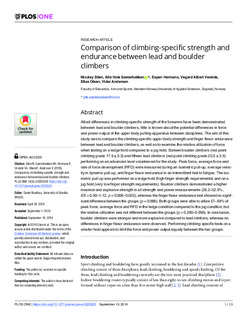| dc.contributor.author | Stien, Nicolay | |
| dc.contributor.author | Sæterbakken, Atle Hole | |
| dc.contributor.author | Hermans, Espen | |
| dc.contributor.author | Vereide, Vegard Albert | |
| dc.contributor.author | Olsen, Elias | |
| dc.contributor.author | Andersen, Vidar | |
| dc.date.accessioned | 2019-10-30T08:58:42Z | |
| dc.date.available | 2019-10-30T08:58:42Z | |
| dc.date.created | 2019-10-24T12:55:49Z | |
| dc.date.issued | 2019 | |
| dc.identifier.citation | Stien, N., Saeterbakken, A. H., Hermans, E., Vereide, V. A., Olsen, E. & Andersen, V. (2019). Comparison of climbing-specific strength and endurance between lead and boulder climbers. Plos One, 14(9). | nb_NO |
| dc.identifier.issn | 1932-6203 | |
| dc.identifier.uri | http://hdl.handle.net/11250/2625313 | |
| dc.description.abstract | Albeit differences in climbing-specific strength of the forearms have been demonstrated between lead and boulder climbers, little is known about the potential differences in force and power output of the upper body pulling-apparatus between disciplines. The aim of this study was to compare the climbing-specific upper-body strength and finger flexor endurance between lead and boulder climbers, as well as to examine the relative utilization of force when testing on a ledge hold compared to a jug hold. Sixteen boulder climbers (red-point climbing grade 17.9 ± 3.3) and fifteen lead climbers (red-point climbing grade 20.5 ± 3.5) performing on an advanced level volunteered for the study. Peak force, average force and rate of force development (RFD) were measured during an isometric pull-up, average velocity in dynamic pull-up, and finger flexor endurance in an intermittent test to fatigue. The isometric pull-up was performed on a ledge hold (high finger strength requirements) and on a jug hold (very low finger strength requirements). Boulder climbers demonstrated a higher maximal and explosive strength in all strength and power measurements (26.2–52.9%, ES = 0.90–1.12, p = 0.006–0.023), whereas the finger flexor endurance test showed no significant difference between the groups (p = 0.088). Both groups were able to utilize 57–69% of peak force, average force and RFD in the ledge condition compared to the jug condition, but the relative utilization was not different between the groups (p = 0.290–0.996). In conclusion, boulder climbers were stronger and more explosive compared to lead climbers, whereas no differences in finger flexor endurance were observed. Performing climbing-specific tests on a smaller hold appears to limit the force and power output equally between the two groups. | nb_NO |
| dc.language.iso | eng | nb_NO |
| dc.publisher | PLoS | nb_NO |
| dc.rights | Navngivelse 4.0 Internasjonal | * |
| dc.rights.uri | http://creativecommons.org/licenses/by/4.0/deed.no | * |
| dc.title | Comparison of climbing-specific strength and endurance between lead and boulder climbers | nb_NO |
| dc.type | Journal article | nb_NO |
| dc.type | Peer reviewed | nb_NO |
| dc.description.version | publishedVersion | nb_NO |
| dc.rights.holder | © 2019 Stien et al. | nb_NO |
| dc.subject.nsi | VDP::Medisinske Fag: 700::Idrettsmedisinske fag: 850::Treningslære: 851 | nb_NO |
| dc.source.pagenumber | 1-13 | nb_NO |
| dc.source.volume | 14 | nb_NO |
| dc.source.journal | PLOS ONE | nb_NO |
| dc.source.issue | 9 | nb_NO |
| dc.identifier.doi | 10.1371/journal.pone.0222529 | |
| dc.identifier.cristin | 1740207 | |
| cristin.unitcode | 203,10,1,0 | |
| cristin.unitname | Institutt for idrett, kosthald og naturfag | |
| cristin.ispublished | true | |
| cristin.fulltext | original | |
| cristin.qualitycode | 1 | |

